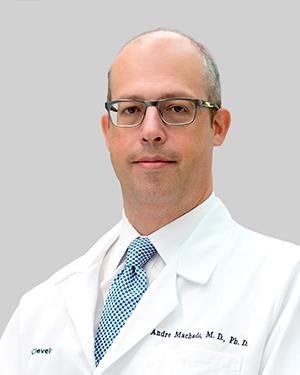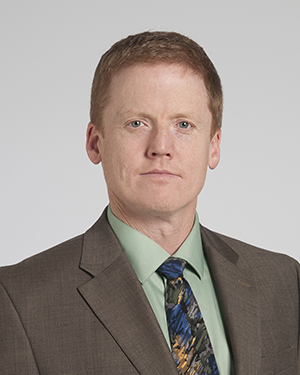Research News
08/15/2023
Cleveland Clinic study shows deep brain stimulation encouraging for stroke patients
First in-human trial phase one results, published in Nature Medicine, build on more than a decade of preclinical research.

Andre Machado, M.D., Ph.D., (left) and Kenneth Baker, Ph.D.
A first-in-human trial of deep brain stimulation (DBS) for post-stroke rehabilitation patients by Cleveland Clinic researchers has shown that using DBS to target the dentate nucleus – which regulates fine-control of voluntary movements, cognition, language, and sensory functions in the brain – is safe and feasible.
Published in Nature Medicine and highlighted by the National Institutes of Health and national media, these findings build on more than a decade of preclinical work led by principal investigators Andre Machado, MD, PhD, and Kenneth Baker, PhD, at Cleveland Clinic.
The EDEN trial (Electrical Stimulation of the Dentate Nucleus for Upper Extremity Hemiparesis Due to Ischemic Stroke) also shows that the majority of participants (nine out of 12) demonstrated improvements in both motor impairment and function. Importantly, the study found that participants with at least minimal preservation of distal motor function at enrollment showed gains that almost tripled their initial scores.
“These are reassuring for patients as the participants in the study had been disabled for more than a year and, in some cases, three years after stroke. This gives us a potential opportunity for much needed improvements in rehabilitation in the chronic phases of stroke recovery,” said Dr. Machado, chair of Cleveland Clinic’s Neurological Institute. “The quality-of-life implications for study participants who responded to therapy have been significant.”
The completed EDEN trial enrolled 12 individuals with chronic, moderate-to-severe hemiparesis of the upper extremity as a result of a unilateral middle cerebral artery stroke 12-to-36 months prior. There were no major complications throughout the study. Nine of the 12 participants improved to a degree that is considered meaningful in stroke rehabilitation.
Each participant underwent DBS surgery, which involved the surgical implantation of electrodes into a part of the brain called the cerebellum. Once connected to a pace-maker-like device, the electrodes were used to deliver small electric pulses to help people recover control of their movements. Following discharge and recovery from the surgery, participants completed months of physical therapy, first with the DBS device turned off for several weeks and then turned on for four-to-eight months. It was after turning the device on that the most significant improvements were observed.
“We saw patients in the study regain levels of function and independence they did not have before enrolling in the research,” Dr. Machado said. “This was a smaller study and we look forward to expanding as we have begun the next phase.”
Read more about the ongoing research and the path forward in the release originally published on Cleveland Clinic's Newsroom.
Featured Experts
News Category
Related News
Want To Support Ground-Breaking Research at Cleveland Clinic?
Discover how you can help Cleveland Clinic save lives and continue to lead the transformation of healthcare.
Give to Cleveland Clinic
